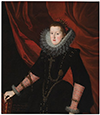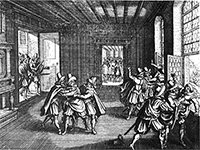King Philip III of Spain
Part 2: Legacy-building
In 1601, Lerma had recommended–and the king had agreed–to move the court to Valladolid, 100 miles southeast of Madrid. The government, however, stayed in Madrid, while Lerma stacked it with his friends and relatives. The experiment ended five years later, when Philip decreed a return of the court to Madrid. Philip, through Lerma, sought peace with various antagonists, as a way to lessen expenditures. England and Spain signed the Treaty of London in 1604 (a year after Philip had refused to help Guy Fawkes and others with the Gunpowder Plot), and the Twelve Years' Truce in 1609 ended the fighting with the Dutch. King and valido also sought to deal with the financial crisis by introducing copper coinage; the experiment failed. One action that Philip III took over the objections of Lerma was the expulsion of the Moriscos, Muslims who had converted to Christianity in order to avoid such expulsion a century earlier. The Spanish Inquisition encouraged by Queen Isabella in the late 15th Century had convinced many By this time, many in the country had had enough of Lerma. his own son, Cristóbal, led an uprising against him. The power of Lerma was such that he kept his position for six years, during which time the king supported him only by not denouncing him. Lerma finally left the court in October 1618. Philip won for his loyal servant a position as a cardinal in Rome. In the wake of all of this warfare and economic and political uncertainty, Spanish arts and literature were flourishing:
In 1615, Philip had arranged for his oldest daughter, Anne, to marry France's King Louis XIII; both Anne and Louis were 14 at the time. In the same year, Prince Philip, the heir apparent, married the French king's sister, Isabella of Bourbon. A cousin of Philip was Ferdinand of Bohemia, who in 1619 became Holy Roman Emperor. A year earlier, as King of Bohemia, Ferdinand had invoked a heavy-handed means to impose Catholicism on his subjects (who included both Austrians and Czechs and were, Philip committed his forces on the side of Ferdinand, and Spanish forces won a significant victory over Czech forces at the Battle of White Mountain in 1620. That was not the end of the war, however. The king had contracted an illness, which proved quite lengthy and, in the end, fatal. He died in Madrid on March 31, 1621. His son, at 16, became King Philip IV. First page > Big Shoes to Fill > Page 1, 2 |
|
Social Studies for Kids
copyright 2002–2025
David White



 He had married Margaret of Austria, his second cousin, in 1599. She was just 15 when they were married and eventually gave birth to eight children: Anne, Maria, Philip, Maria Anna, Charles, Ferdinand, Margaret, and Alonso. She died in 1611, in childbirth; she was just 26. Philip did not remarry.
He had married Margaret of Austria, his second cousin, in 1599. She was just 15 when they were married and eventually gave birth to eight children: Anne, Maria, Philip, Maria Anna, Charles, Ferdinand, Margaret, and Alonso. She died in 1611, in childbirth; she was just 26. Philip did not remarry. who professed to Islam to publicly renounce such beliefs and announce themselves as Christians; however, the Inquisition also targeted many of those same people on suspicion that they were paying lip service to their religious conversion and were, secretly or perhaps not so secretly, still believing themselves to be Muslims. By the time of Philip III, suspicion of these people (who were descendants of those who originally converted) had once again grown, and the king decided that the answer was an order to leave the country. Philip III made just a pronouncement in 1609; during the next five years, nearly 300,000 people left the country, taking with them their labor skills and tax-paying ability. In order to help facilitate this large-scale expulsion, Philip ordered his navy and a 30,000-man-strong army to make sure that the Moriscos left Spain, bound for Morocco or Tunis.
who professed to Islam to publicly renounce such beliefs and announce themselves as Christians; however, the Inquisition also targeted many of those same people on suspicion that they were paying lip service to their religious conversion and were, secretly or perhaps not so secretly, still believing themselves to be Muslims. By the time of Philip III, suspicion of these people (who were descendants of those who originally converted) had once again grown, and the king decided that the answer was an order to leave the country. Philip III made just a pronouncement in 1609; during the next five years, nearly 300,000 people left the country, taking with them their labor skills and tax-paying ability. In order to help facilitate this large-scale expulsion, Philip ordered his navy and a 30,000-man-strong army to make sure that the Moriscos left Spain, bound for Morocco or Tunis. Miguel de Cervantes (right) published the first part of his epic Don Quixote de la Mancha during this time (in two parts, 1605 and 1615).
Miguel de Cervantes (right) published the first part of his epic Don Quixote de la Mancha during this time (in two parts, 1605 and 1615). in large part, Protestant). The Bohemian nobles who met with Ferdinand's representatives at Prague Castle were so incensed that they threw his representatives out a window. Such began the open revolt that unofficially began the
in large part, Protestant). The Bohemian nobles who met with Ferdinand's representatives at Prague Castle were so incensed that they threw his representatives out a window. Such began the open revolt that unofficially began the 
